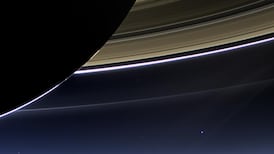Gaze up at the night sky and you catch a glimpse of infinity. The stars seem numberless; the immensity of the universe is profoundly impressive, leading us to wonder about the nature of our cosmic home. Is space finite or unlimited in extent? If it is bounded, what lies outside? The notion of infinity is among the great intellectual challenges facing humanity.
The Greek mathematician and philosopher Archytas developed a clever argument for an unlimited universe, asking: “If I arrived at the outermost edge of the heavens, could I not extend my hand or staff into what is outside?” Put simply, if the universe is bounded, what lies beyond it?
Infinity originally fell within the domain of philosophers and theologians, who have been agonising for millennia over the paradoxes and dilemmas associated with the concept. Today, it is a key concern of mathematics. The concept of the infinite is also of central relevance in physics and cosmology. David Hilbert, one of the most brilliant mathematicians of the 20th century, observed that “no other concept has ever moved so profoundly the spirit of man ... yet no other concept stands in greater need of clarification than that of the infinite”.
Contemporary physics is seriously investigating the possibility that neither space nor time is infinitely divisible. The overall shape of space is unknown, and there are many different possibilities
We encounter infinity early in our education when we find there is no largest number: the sequence 1, 2, 3 ... continues forever. Galileo realised that each number has a square, and every square has a corresponding root: there is a perfect pairing between numbers and their squares, so the two sets must be the same size. But this is paradoxical, since there are many numbers that are not squares.
READ MORE
Galileo was perplexed, concluding that sizes of unlimited sets are meaningless. Two hundred and fifty years later, Georg Cantor devised his theory of transfinite numbers, resolving Galileo’s paradox but giving rise to even greater enigmas. Having proved that the points of a square are equal in number the points on an edge of that square, Cantor wrote to his friend Richard Dedekind: “I see it but I don’t believe it!”
Cantor, who single-handedly invented set theory, proved a stunning theorem, showing that not only are the counting numbers unlimited, but the colossally greater set of transfinite numbers continues endlessly to an unreachable Absolute, which Cantor denoted by omega and linked to the divine.
In geometry we learn that there is an infinitude of points on a line segment: given any two points, we can always find a third lying between them. In physics as well as mathematics, we learn that infinity has many guises.
There is the infinitely large as with sets of numbers or the extent of physical space. And there is infinite divisibility: we may have unlimited points on a line, but can physical space be repeatedly subdivided without limit? Quantum theory seems to put a bound on how small we can go. But is this the end, or are there sub-quantum worlds yet to be discovered?
Contemporary physics is seriously investigating the possibility that neither space nor time is infinitely divisible. The overall shape of space is unknown, and there are many different possibilities.
Is space quantised with some crystalline structure? Is there a shortest time, a basic and irreducible Augenblick or clock-tick? Carlo Rovelli, who writes lucidly on modern physics, recognised how inconclusive are our speculations about the infinite nature of the universe: “What is truly infinite may just be the abyss of our ignorance.”
Peter Lynch is emeritus professor at the school of mathematics and statistics in University College Dublin. He blogs at thatsmaths.com
- Sign up for push alerts and have the best news, analysis and comment delivered directly to your phone
- Join The Irish Times on WhatsApp and stay up to date
- Listen to our Inside Politics podcast for the best political chat and analysis













